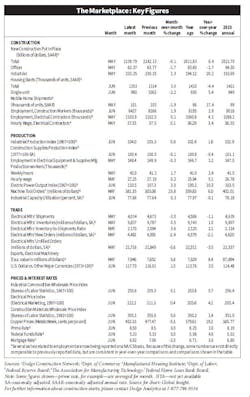Latest from U.S. Economy
New Data for Electrical Product Sales Estimates
Electrical Marketing - December 20, 2024
Electrical Marketing's Key Economic Indicators
Electrical Marketing's Leading Economic Indicators - 7/25/2024 Update
Building permits come in with mixed results.
June building permits were at a seasonally adjusted annual rate of 1,446,000, +3.4% above the revised May rate of 1,399,000, but -3.1% YOY below last year's rate of 1,493,000. Single-family authorizations in June were at a rate of 934,000, -2.3% below the revised May figure of 956,000.
Architects looking for lower rates to spur billings increase.
Business conditions remained soft at architecture firms in June with the American Institute of Architects (AIA)/Deltek Architecture Billings Index (ABI) reporting a score of 46.4 points. Any score below 50 points indicates a billings decline.
“Architecture firms continue to face a period of headwinds in the construction sector, driven by elevated interest rates, high construction costs, and generally weak property values,” said Kermit Baker, AIA chief economist, in the press release. “This is the 17th consecutive month of a billings decrease and yet, despite the softness firms remain generally optimistic that conditions will start to improve once interest rates begin to ease.”
Conference Board’s Leading Indicators continues to show bearish signs.
The Conference Board Leading Economic Index (LEI) for the U.S. declined by -0.2% in June 2024 to 101.1 (2016=100), following a decline of -0.4% (upwardly revised) in May. Over the first half of 2024, the LEI fell by -1.9%, a smaller decrease than its -2.9% contraction over the second half of last year.
“The U.S. LEI continued to trend down in June, but the contraction was smaller than in the past three months,” said Justyna Zabinska-La Monica, senior manager, Business Cycle Indicators, at The Conference Board. “The decline continued to be fueled by gloomy consumer expectations, weak new orders, negative interest rate spread, and an increased number of initial claims for unemployment.
“However, due to the smaller month-on-month rate of decline, the LEI’s long-term growth has become less negative, pointing to a slow recovery. Taken together, June’s data suggest that economic activity is likely to continue to lose momentum in the months ahead. We currently forecast that cooling consumer spending will push U.S. GDP growth down to around +1% (annualized) in Q3 of this year.”










